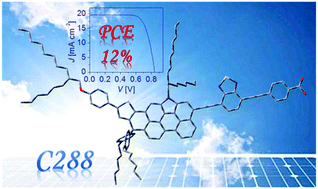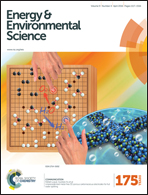Improving the performance of dye-sensitized solar cells with electron-donor and electron-acceptor characteristic of planar electronic skeletons†
Abstract
The design of a photosensitizer characteristic of both excellent absorption of infrared solar photons and high external quantum efficiencies (EQEs) should be a momentous stride towards the further performance improvement of dye-sensitized solar cells. In this paper, by using a binary twisting electron-donor triphenylamine-phenanthrocarbazole (TPA-PC) we first demonstrate that the transformation of the electron-acceptor from twisting 4-(benzo[c][1,2,5]thiadiazol-4-yl)benzoic acid (BTBA) to planar 4-((7-ethynylbenzo[c][1,2,5]thiadiazol-4-yl)ethynyl)benzoic acid (EBTEBA) can significantly stabilize the lowest unoccupied molecular orbital (LUMO) energy level of an organic dye but does not lower EQEs. Also we show that the application of the electron-donor 11-(2-hexyldecyl)-8-(4-((2-hexyldecyl)oxy)phenyl)-6,6-bis(4-hexylphenyl)-6,11-dihydrothieno[3′,2′:8,9]chryseno[10,11,12,1-bcdefg]carbazole (P-TCC) with a planar electronic skeleton, featuring a comparable electron-releasing strength to the twisting counterpart TPA-PC, can enhance the absorption of infrared solar photons, without reducing the energy gap between the highest occupied molecular orbital (HOMO) and LUMO. Dye C288 with P-TCC as the electron-donor and EBTEBA as the electron-acceptor retains an almost planar electronic skeleton and a high power conversion efficiency of 12%. Stationary and femtosecond dynamic photoluminescence (PL) measurements have suggested cascade excited state relaxations and multiple-state electron injections at the titania/dye interface, in collaboration with theoretical calculations on the excited state conformations.


 Please wait while we load your content...
Please wait while we load your content...